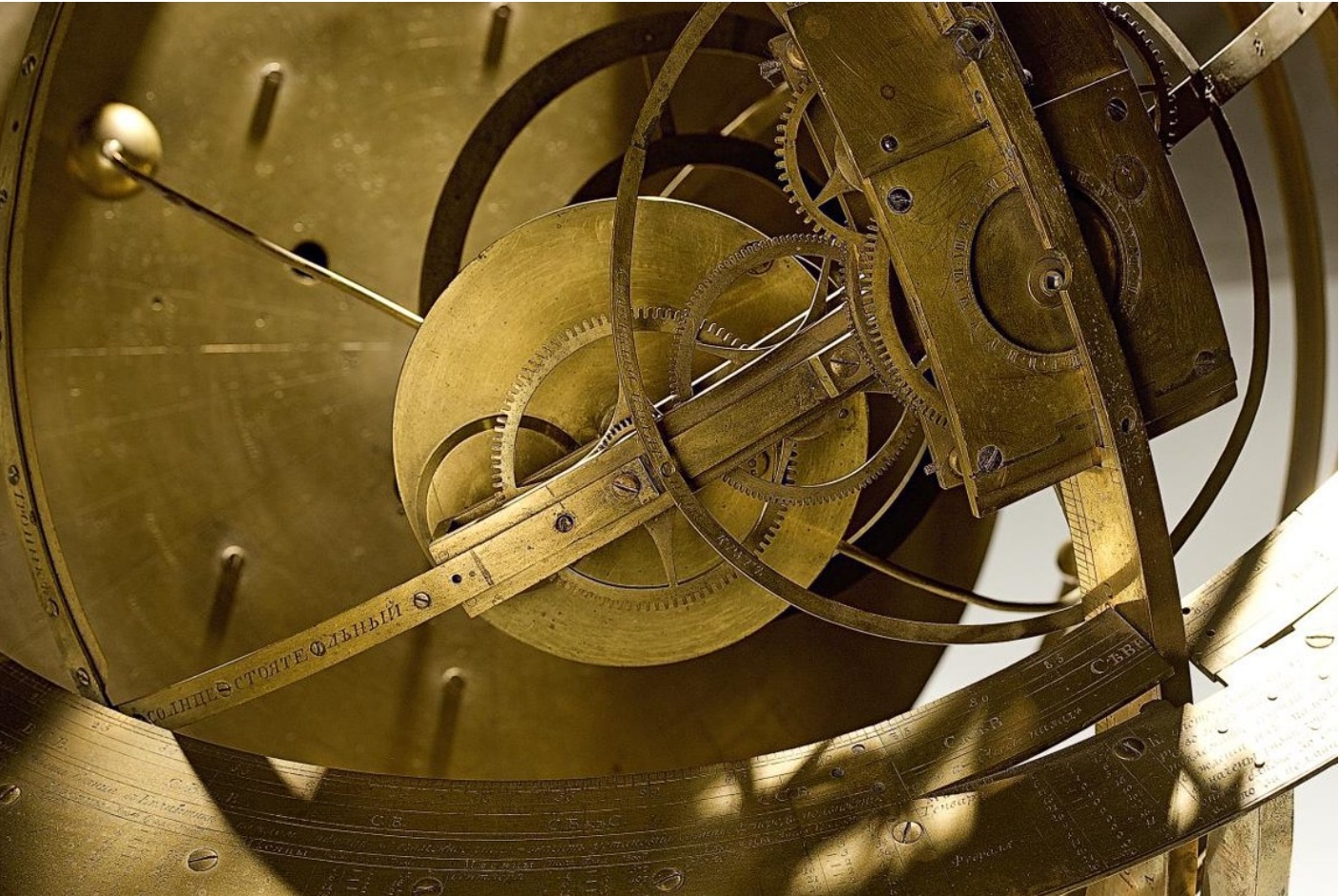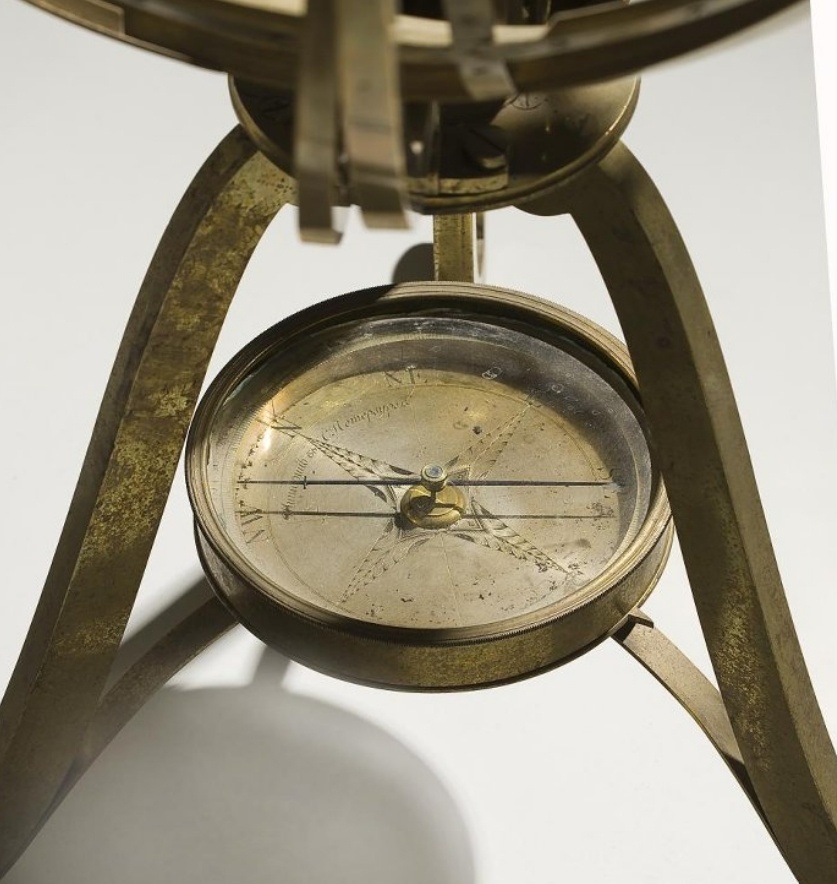Project for the Restoration of an Armillary Sphere
 Armillary sphere presenting the structure of the Solar System according to the heliocentric model. Saint Petersburg. Made by the mechanic Osip Shishorin to Piotr Shelekhov’s design. 1801–03 Brass, steel, glass. Techniques: metalworking and turning, engraving, silvering. Height: 84 cm; diameter: 55 cm.
Armillary sphere presenting the structure of the Solar System according to the heliocentric model. Saint Petersburg. Made by the mechanic Osip Shishorin to Piotr Shelekhov’s design. 1801–03 Brass, steel, glass. Techniques: metalworking and turning, engraving, silvering. Height: 84 cm; diameter: 55 cm.This exhibit is one of the first armillary spheres (mechanical models of the Solar System) to have been made in Russia. Such devices were very popular in the 17th and 18th centuries, being used for purposes of education and more general enlightenment. They were a symbol of scientific learning and progress (an armillary sphere was notably placed on top of the building of the Kunstkammer in Saint Petersburg).
This armillary sphere was made by Osip Ivanovich Shishorin, one of the most gifted graduated of the instrumental class at the Saint Petersburg Academy of Arts who went on to become its head, to the design of Piotr Osipovich Shelekhov, an outstanding Russian seafarer and cartographer who worked in the Commission for the Establishment of Colleges and produced maps, charts and globes. The sphere stands out for the true elegance of its construction and its highly meticulous execution. It includes depictions of the night sky, the signs of the Zodiac, the Sun, Earth and Moon. One of its distinctive features is the inclusion of a clockwork mechanism which makes it possible to demonstrate the movement of the planets on a realistic timescale. The device bears the names of both its designer and the master craftsman. The horizontal ring of the stand carries the engraved inscription: “Composition of the Court Councillor P. Shelekhov. St Petersburg 1801. Work of the Mechanic of the 9th Class Ios. Shishorin”. Another on the scale of the compass reads “Shishorin in St Petersburg”. All the inscriptions and marks on the device are made with Cyrillic letters and in Russian (apart from the marking of the compass scale).

The sphere, consisting of an arrangement of rings, is supported by a stand with three curved legs. A compass is fitted within the base of the stand. The horizontal ring of the stand carries a scale in degrees and letters marking 32 compass points, as well as tables of co-ordinates (precise to the half-minute) of various geographical locations on Earth (grouped by continent and, in the case of Europe and Asia, by country).
Among the heavenly bodies, only the Sun, Earth and Moon are represented in the device, with their movement being driven by the clockwork. This makes it possible to track their changing locations. To determine the current position of the Sun, Earth and Moon at a given moment in time. the user would need to set up the sphere and the heavenly bodies in accordance with the specific astronomical situation for a specific geographical location and then wind up the clockwork and set it going.
The device received the approval of the Saint Petersburg Academy of Sciences and was given a high assessment by scholars. In 1803, Shelekhov presented the armillary sphere to Emperor Alexander I and it was installed in the Imperial Hermitage.
This remarkable creation of Russian science and mechanics has featured in works by leading researchers into the history of science and instrument-making in this country. They were Valentin Lukich Chenakal (1912–1977), long-time Director of the Mikhail Lomonosov Museum, a major Soviet historian of science and scientific devices, who made a special publication about the first armillary spheres produced in Russia, and Vladimir Yuryevich Matveyev (1948–2015), for many years the keeper of scientific devices and instruments in the State Hermitage’s Department of the History of Russian Culture, who studied the history of the horological and instrumental classes of the Academy of Arts and published (among many other works) Mechanical Arts and the Imperial Academy of Arts (2010).
State of Preservation
The device has suffered numerous losses of structural and decorative elements and undergone later alterations and adjustments. At the present moment, the clockwork mechanism is not functioning.
The project plan calls for the following work to be carried out:
- the study of prototypes and analogues, examination of the structure and condition of the framework and the mechanism
- correction of surface defects
- reconstruction of losses, restoration of the clockwork mechanism and the mechanism for the movement of the heavenly bodies
- assembly and tuning of the armillary sphere
- preparation of a report and presentation.
On completion of the restoration, the armillary sphere will take its place in the permanent display of the State Hermitage.
A working group of members of the State Hermitage staff has been formed for the restoration of the device:
scholarly supervisor – Grigory Yastrebinsky, keeper of the exhibit, senior researcher in the State Hermitage’s Department of Russian Culture
co-ordinator – Yevgeny Feodorov, head of the Project Finance Sector
curator – Mikhail Guryev, head of the Laboratory for the Scientific Restoration of Timepieces and Musical Instruments
performers – artist-restorers of the Laboratory for the Scientific Restoration of Timepieces and Musical Instruments


